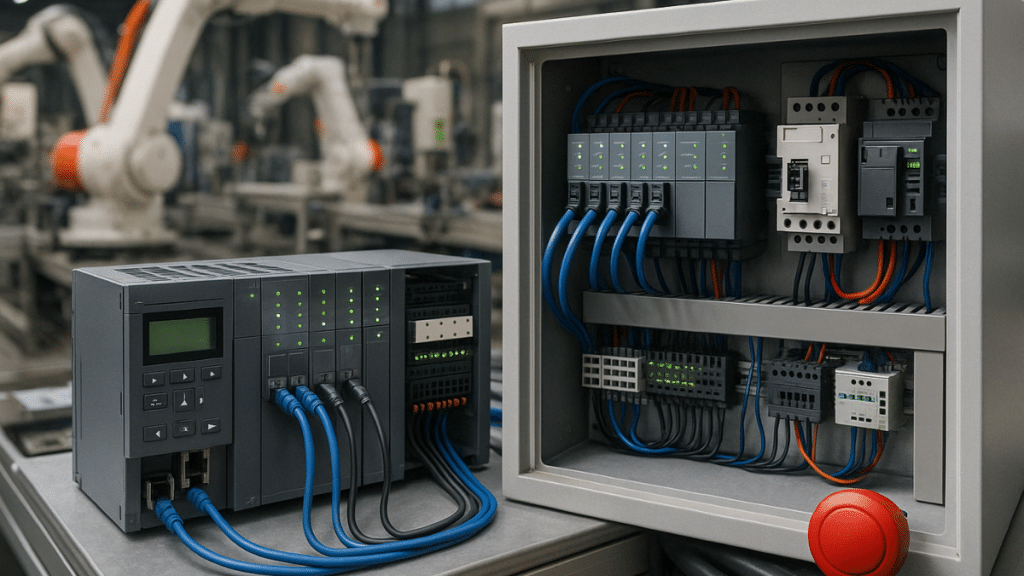Modern industries are embracing automation and smart systems to boost precision, safety, and efficiency. As factories grow increasingly digital, real-time monitoring and coordinated equipment control have become non-negotiable. One silent yet essential component behind this evolution is the programmable logic controller. A reliable PLC system for industrial automation ensures smooth machine operation, tracks production metrics, and maintains system synchronisation. Without it, even the most advanced setups face unexpected breakdowns and productivity dips.
The Role of PLCs in Smart Manufacturing
At the heart of any automated system lies the need for consistent, real-time control. PLCs are designed to receive input from sensors and other field devices, process that data based on predefined logic, and trigger appropriate output responses. Whether it’s regulating the speed of a conveyor belt, synchronising robotic arms, or managing temperature controls in a processing unit, PLCs act as the command centre for all automated operations.
For smart factories that operate in a high-speed, data-intensive environment, the reliability and speed of PLCs become even more critical. The sophistication of automation today demands that these devices perform at optimal capacity, often under extreme conditions, without error or interruption. Any fault, however small, could disrupt the entire system.
Adaptability and Scalability
A significant reason for incorporating PLC systems in smart factories is their adaptability. These controllers can be configured for a variety of applications, making them suitable across multiple industries, including automotive, food processing, and pharmaceuticals. As production requirements shift, the logic in the PLC can be reprogrammed, enabling the same piece of equipment to perform entirely different tasks. This makes them ideal for dynamic production environments where flexibility is paramount.
Moreover, PLCs are inherently scalable. Factories can begin with a simple control setup and expand gradually as operations grow, integrating additional modules and networks without overhauling the entire system. This modularity not only reduces costs but also simplifies maintenance and upgrades, ensuring long-term operational resilience.
Precision and Error Reduction
Smart factories prioritise accuracy, and this is another area where PLCs shine. Unlike manual operations or rudimentary control systems, PLCs execute instructions with exceptional precision and accuracy. This reduces the risk of error, enhances quality control, and limits product wastage.
Employing reliable PLC setups ensures uniformity in production cycles. Operators can monitor and modify processes in real time based on data collected through interconnected systems. As a result, decision-making becomes quicker, more informed, and less prone to human error. This level of control is crucial in industries where even minor deviations can lead to compliance issues or product recalls.
Real-Time Monitoring and Predictive Maintenance
One of the most compelling arguments for deploying a strong PLC network is the ability to monitor machinery in real-time. Through constant data collection, PLCs enable operators to track equipment performance, identify inefficiencies, and address faults before they escalate into critical failures.
This feeds directly into the framework of predictive maintenance, a cornerstone of smart manufacturing. Rather than responding to equipment breakdowns after they occur, factories can predict when a device is likely to fail and schedule maintenance accordingly. This shift from reactive to proactive management dramatically reduces downtime and preserves valuable resources.
Cybersecurity and Network Integration
As industrial setups become increasingly connected, cybersecurity emerges as a priority. PLCs must now not only communicate with field devices but also with supervisory systems, data servers, and sometimes even remote platforms. Ensuring this communication is secure is vital to maintaining the integrity of the production system.
Modern PLCs support encrypted protocols and firewall features to safeguard factory networks from external threats. They are also designed to integrate seamlessly with other control systems, such as SCADA and HMI, creating a unified platform that boosts visibility and centralised control.
A well-integrated PLC system ensures that all components, from basic switches to complex analytical devices, can work in harmony. This harmonisation is critical in achieving the level of efficiency and synchronisation that smart factories require to stay competitive.
Reduced Operational Costs
One clear benefit of a dependable PLC system is its ability to reduce operational costs. Though the upfront cost of quality equipment can be considerable, the efficiency gains over time more than compensate. Automation lowers reliance on manual tasks, cuts down on mistakes, and speeds up production workflows.
Efficient control over energy usage is achievable by operating machinery and electrical equipment strictly as needed. This targeted approach reduces power expenses, lessens mechanical stress, and supports a more sustainable and streamlined manufacturing environment.
The Need for Quality Partnerships
No matter how advanced the technology, its effectiveness ultimately depends on its proper implementation and effective maintenance. That’s where partnering with reputable energy and industrial equipment providers becomes invaluable. By working with established experts, factories gain access not only to superior-grade PLC systems but also to guidance on best practices, regular servicing, and ongoing support.
Reliable partners ensure that installations meet industry standards, are compliant with safety regulations, and are tailored to the specific needs of each production unit. Their expertise can make the difference between an operational system and an optimised one.
Looking Ahead: Building Smarter, Stronger Factories
A dependable PLC setup has become essential for any smart factory. It seamlessly combines efficiency, adaptability, safety, and oversight within a scalable framework. As the manufacturing sector continues its shift towards digital integration, success will largely depend on those who not only adopt advanced equipment but also forge strong alliances with reliable energy partners. These collaborations help maintain smooth operations now while ensuring readiness for future demands.

